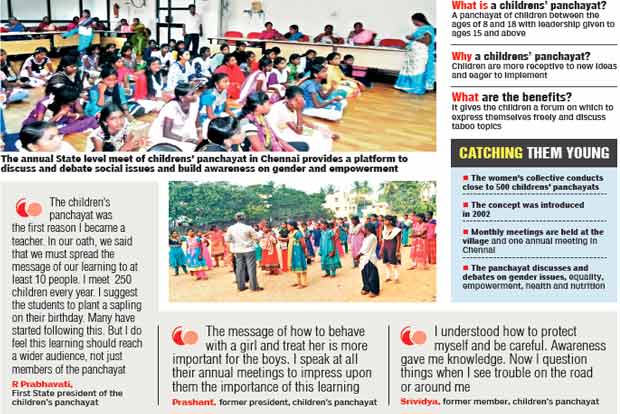Begin typing your search...
A panchayat for and by the children
When R Prabhavati first attended a panchayat meeting at her village, she was blown away by the experience.

Chennai
Children holding forth, children debating and children officiating! It was a panchayat of the children, for the children and by the children! The oath she took then, as a child panchayat member, that she would not drink carbonated drinks, she keeps it to this day.
“Initially, it was home and school and back. I was lost in my own world. After attending the childrens’ panchayat, I started observing things, paying attention to events around me,” says Prabhavati, who went on to become the first president of Tamil Nadu’s childrens’ panchayat in 2009.
The childrens’ panchayat is a concept introduced in 2002 by the Tamil Nadu Women’s Collective, a group that has been working on womens’ issues for over two decades. The idea behind this is to catch them young, says Sheelu Francis of the Women’s Collective. “In 2001, after local elections, we found that our membership did not get converted into votes. Our analysis showed that despite all the inputs we gave the women, when it came to decision making, they depend upon their men or their caste leader. It was really frustrating.”
Although women stood up for each other when it came to womens’ issues, on social issues, the men took the call. With a membership of around 65,000 at the time, the collective felt the need to reach out in some other way since a majority of the women were set in their ways and unwilling to or unable to shed established value systems and beliefs.
“For 25 years, they have had one value system. We were giving them a new set of values for one or two years and then expecting them to relearn. We found that they are not able to sustain that,” she says. This led them to the idea of children’s panchayats in 2002, an attempt at `democratising the youth’. The idea was to create a band of capable representatives who could speak for the people when it was their time to lead.
Collective workers organised monthly meetings for the panchayat that is headed by a president and a vice-president. Debates are conducted on current affairs, gender issues, sexual harassment, issues of religion and caste discrimination. Children are encouraged to share their ideas and discuss their thoughts of an ideal world. What started with 5-6 villages today spans 500 villages.
Children in the 8-18 year age groups participate in the panchayats, with leadership positions being given to children aged 15 and above.
At the monthly session, children are taught to play games, share experiences and talk about issues that trouble them. Says Srividya, a former member of a children’s panchayat from Dharmapuri, “At one session, we were given an orientation into harassment and then all of us asked to write about our experiences, anonymously. The notes were then mixed up and picked out randomly. One of the girls had written that she was often exposed to a `bad touch’ by her older sibling but that she had always assumed it was ok. The learning that it was not ok had troubled her! We brought that note to the co-ordinator who then took it up with the family of the girl and sorted it out. That came as a shock to me, but taught me to protect myself”. The panchayat has also counselled students on exam failure and had prevented students from committing suicide.
There is a State level summer camp and a district level winter season camp that brings all the members together for better interaction and understanding. Leadership training and team building exercises are conducted. “The idea is to divert them from television, “ says Sheelu.
In 2003, at the end of a `model panchayat’ meeting, the children resolved not to use plastic covers. As they dispersed, some of the field workers picked up their bags to leave. An eight-year-old member came up asking, “We have just resolved not to use plastics and here you are with your plastic bags…”. “The realisation that when children find an idea appealing, they want it implemented immediately, struck me hard,” says Sheelu who was determined to intensify the programme. The children resolved to stay away from carbonated drinks, not to use plastic covers and to plant saplings on their birthdays. Many children still continue to practice some of these habits, she says. There are childrens’ panchayats that have petitioned the grama sabha for streetlights and better roads and had them fulfilled, says Prabhavati.
Where is the impact of the panchayat most visible? “Nutrition, growing and consumption of vegetables, avoiding packed junk food and a subtle change in gender dynamics, with girls learning to assert and express themselves,” says Sheelu.
When Prashant, a child panchayat president from Vellore, started working as a physical instructor at a school, he insisted and convinced the school management not to differentiate between girls and boys in the type of games they could and could not play. At Prashant’s panchayat, the children got together and organised a peaceful protest against a liquor shop near their school and got it removed in 2011.
In what might be seen as a dampener, the collective since 2010 discontinued the practice of bringing the boys to the State level camps because of the difficulties in hosting them owing to paucity of funds.
However, messaging with respect to gender justice is of utmost importance for boys and the collective is now targeting the mothers of boys, impressing upon them the need to let the boys do household chores and learn to treatwomen equally.
Send your comments to: NRD.thanthi@dt.co.in
News Research Department
Visit news.dtnext.in to explore our interactive epaper!
Download the DT Next app for more exciting features!
Click here for iOS
Click here for Android
Next Story



